The Crucial BX300 (480GB) SSD Review: Back To MLC
by Billy Tallis on August 29, 2017 9:00 AM ESTSequential Read Performance
Our first test of sequential read performance uses short bursts of 128MB, issued as 128kB operations with no queuing. The test averages performance across eight bursts for a total of 1GB of data transferred from a drive containing 16GB of data. Between each burst the drive is given enough idle time to keep the overall duty cycle at 20%.

The sequential read burst speed of the Crucial BX300 is faster than any previous Crucial drive, but only just barely catches up to the rest of the market.
Our test of sustained sequential reads uses queue depths from 1 to 32, with the performance and power scores computed as the average of QD1, QD2 and QD4. Each queue depth is tested for up to one minute or 32GB transferred, from a drive containing 64GB of data.

The sustained sequential read performance of the BX300 actually shows a regression from the BX200, though both drives fall in the middle of the pack and above Crucial's MX drives. The fastest SATA SSD (Samsung 850 PRO) is 45% faster than the BX300, and even the Intel 545s is 22% faster.
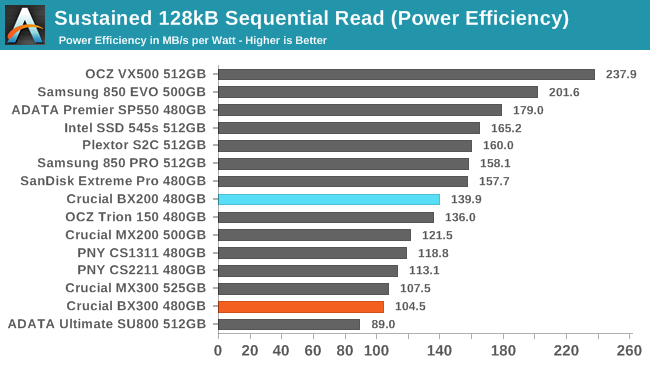
The power efficiency of the Crucial BX300 on the sequential read test is poor, and the other two drives that use Micron's 3D NAND (as TLC) join the BX300 at the bottom of the chart. The Intel 545s does well on this efficiency score, so Micron will probably be able to shore up this weakness in future products when they adopt their 64L 3D NAND.
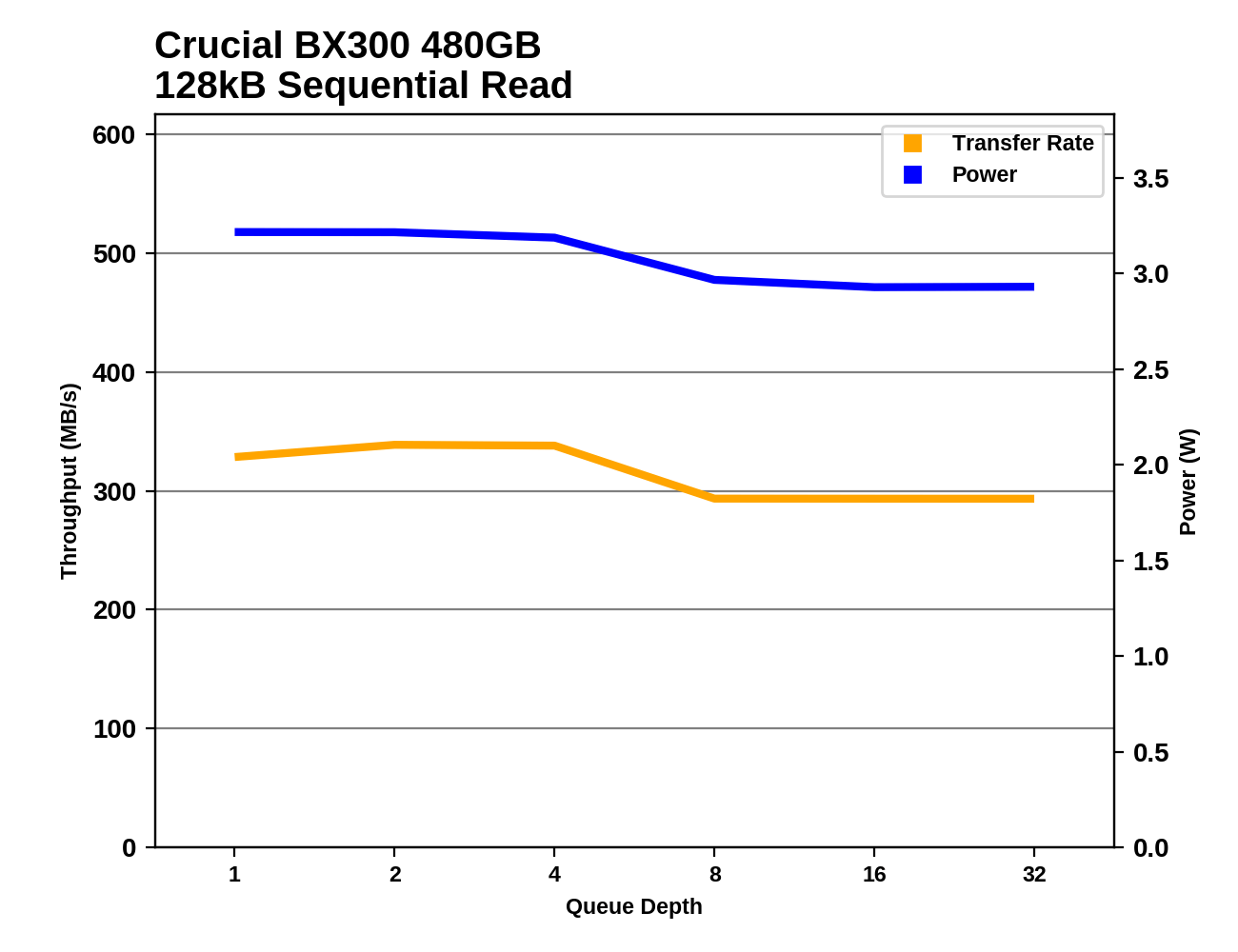 |
|||||||||
Samsung's SSDs are the best-behaved on this test, with performance saturating at QD2 and consistently staying there through the rest of the test. The MX300 is also quite consistent through this test, but with much lower performance overall.
Sequential Write Performance
Our test of sequential write burst performance is structured identically to the sequential read burst performance test save for the direction of the data transfer. Each burst writes 128MB as 128kB operations issued at QD1, for a total of 1GB of data written to a drive containing 16GB of data.
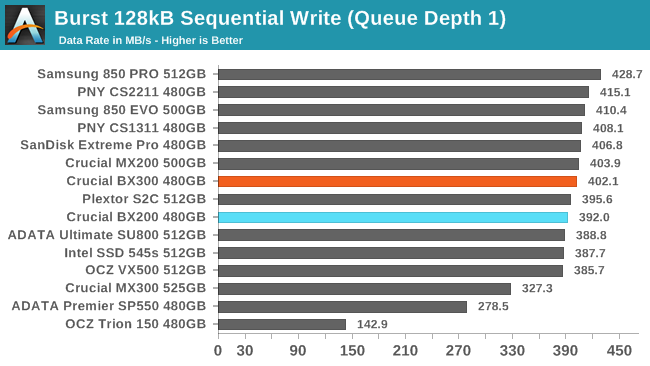
The burst sequential write speed of the BX300 is good, but not enough for it to stand out from the crowd or to beat the MX200. The MX300 stands out for being substantially slower than most SATA SSDs.
Our test of sustained sequential writes is structured identically to our sustained sequential read test, save for the direction of the data transfers. Queue depths range from 1 to 32 and each queue depth is tested for up to one minute or 32GB, followed by up to one minute of idle time for the drive to cool off and perform garbage collection. The test is confined to a 64GB span of the drive.
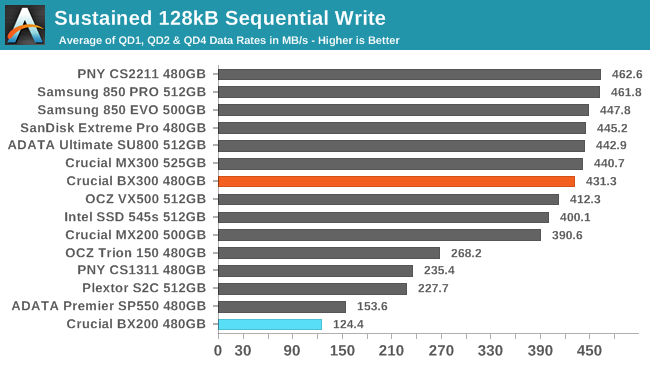
On the longer sequential write test, the BX300 stays in the top half of the chart and performs close to the top tier of drives, but is a bit slow given that it uses 3D MLC.
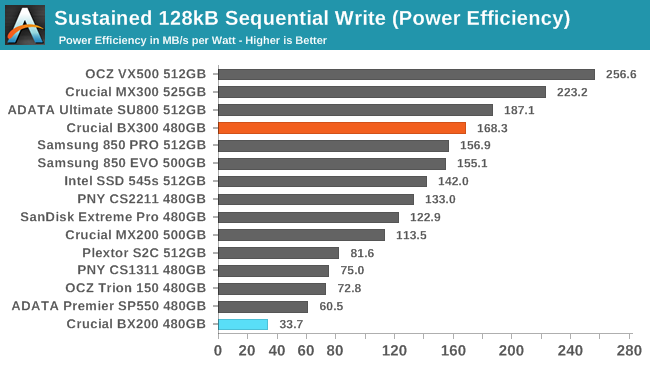
The power efficiency of the Crucial BX300 is a bit better than Samsung's SSDs, but the drives using Micron's 3D TLC are more efficient and Toshiba's OCZ VX500 is in the lead by a substantial margin.
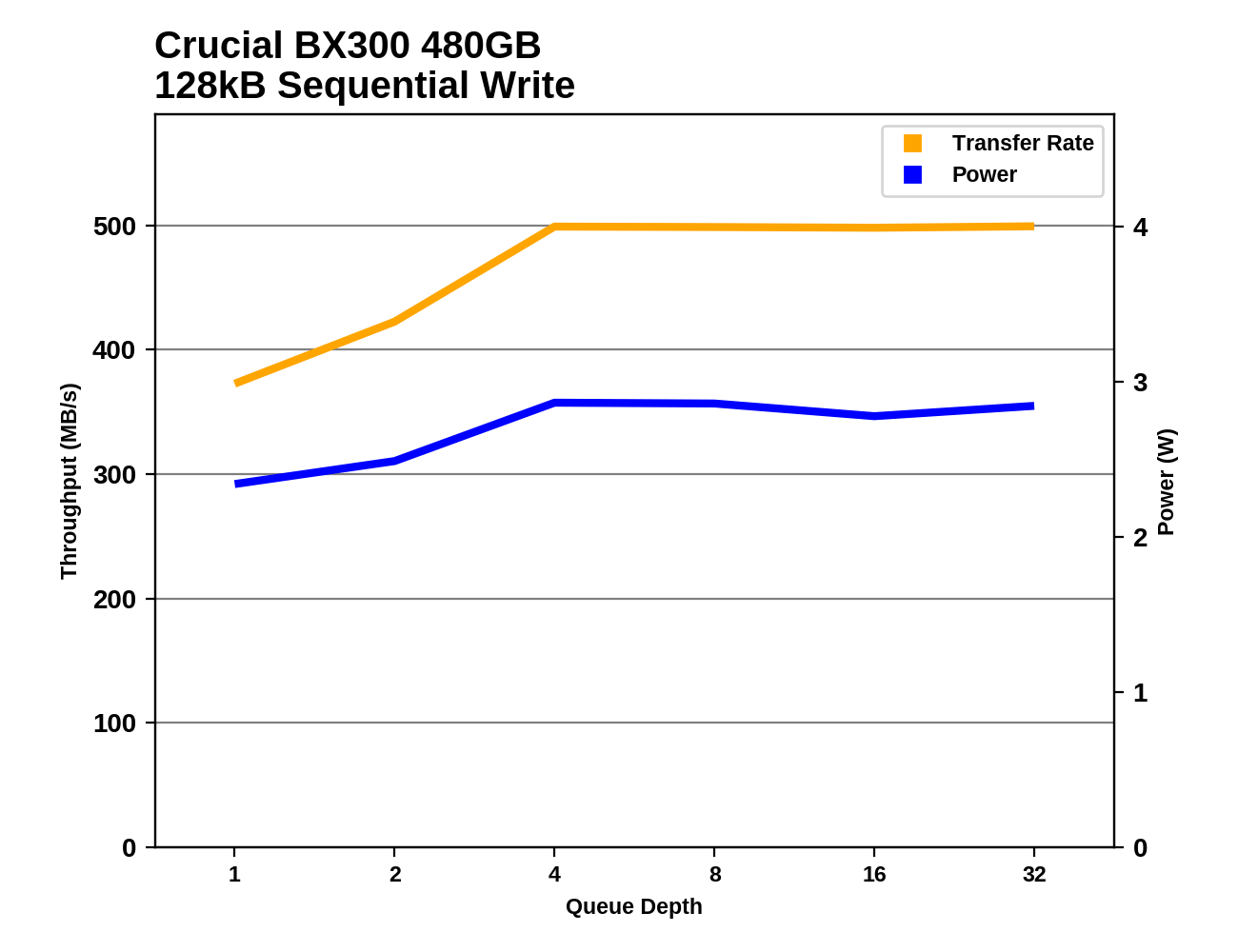 |
|||||||||
The Crucial BX300's sequential write speed saturates at QD4 and it performs steadily thereafter, but at QD2 it is much slower than its maximum and is outperformed by many SSDs.










90 Comments
View All Comments
nathanddrews - Tuesday, August 29, 2017 - link
SSD prices at Microcenter dropped by about 25% over the weekend (850 EVO 500GB for $139) and Amazon and Newegg are also down a bit, I assume the NAND shortage is over? Just clearing inventory? I'm really happy to see MLC back in the mix! Time to upgrade the last of the mechanical computers...ddriver - Tuesday, August 29, 2017 - link
Oh no it is not. They are gonna milk that cow until Chinese NAND gets to the market. And then they will short the price.On a side note, way to go Crucial - making quality products with MLC flash, with endurance worse than that of TLC flash. It is quite the achievement.
ddriver - Tuesday, August 29, 2017 - link
On the bright side, it is good to see that the competition is finally catching up to samsung SATA SSDs. Be that a couple of years after they stopped developing SATA SSDs.Yojimbo - Tuesday, August 29, 2017 - link
I think Chinese production of NAND and DRAM will be by new companies operating in new foundries. Volume production probably won't be reached until 2019, and can we really be sure of what to expect when it does?leexgx - Saturday, September 2, 2017 - link
you do know that endurance actually means warranty void if you use more than the endurance rating, MLC drives norm have endurance levels of PB of data before issues start to happenlove the BX100 for its near 0 power use when idle but it does choke a little under high load meaning i actually notice it slightly when its struggling but still its many times faster then a HDD witch can get tied up under medium loads (like windows update and store)
be nice if they can replicate that on the BX300 (should be better than the BX100 due to SLC cache and improved controller )
Ryan Smith - Tuesday, August 29, 2017 - link
The NAND shortage is definitely not over. That won't abate until some time in 2018.I couldn't say if it was clearing inventory, a short-term deal, or something else, but right now there's no reason to believe any kind of price cuts will stick.
nathanddrews - Tuesday, August 29, 2017 - link
So what you're saying is "get it while it's hot"?Ryan Smith - Wednesday, August 30, 2017 - link
Yup.BrokenCrayons - Tuesday, August 29, 2017 - link
I picked up a 480GB Muskin Reactor Armor3D for $139 _very_ recently dropped from $149. Like you, I was wondering if the NAND shortage was coming to an end, but Ryan is in a good position to know these things so maybe there's just a good deal on at the moment.Alexvrb - Tuesday, August 29, 2017 - link
MLC or not the TLC Evo is still the better performing drive. If you're buying a ~250GB model the Evo is hands down the best option. At 500GB-1TB capacities there are a couple of cheaper options that are tempting but the Evo is still the best deal for the money IMHO until you hit 2TB class drives, where the MX300 really shines.